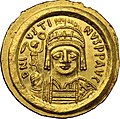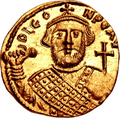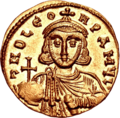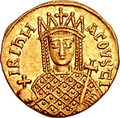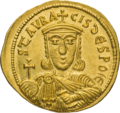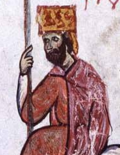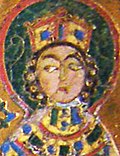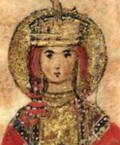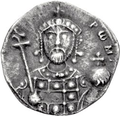| Emperor and Autocrat of the Romans | |
|---|---|
Imperial | |
 | |
| Details | |
| First monarch | Constantine the Great (historiographical convention) |
| Last monarch | Constantine XI Palaiologos |
| Formation | 11 May 330 |
| Abolition | 29 May 1453 |
| Residence | Great Palace, Blachernae Palace |
| Appointer | Unspecified, de facto hereditary [1] [a] |
The foundation of Constantinople in 330 AD marks the conventional start of the Eastern Roman Empire, which fell to the Ottoman Empire in 1453 AD. Only the emperors who were recognized as legitimate rulers and exercised sovereign authority are included, to the exclusion of junior co-emperors who never attained the status of sole or senior ruler, as well as of the various usurpers or rebels who claimed the imperial title.
Contents
- Constantinian dynasty (306–363)
- Valentinianic dynasty (364–392)
- Theodosian dynasty (379–457)
- Leonid dynasty (457–518)
- Justinian dynasty (518–602)
- Heraclian dynasty (610–695)
- Twenty Years' Anarchy (695–717)
- Isaurian (Syrian) dynasty (717–802)
- Nikephorian dynasty (802–813)
- Amorian dynasty (820–867)
- Macedonian dynasty (867–1056)
- Doukas dynasty (1059–1078)
- Komnenos dynasty (1081–1185)
- Angelos dynasty (1185–1204)
- Laskaris dynasty (1205–1261)
- Palaiologos dynasty (1259–1453)
- See also
- References
- Notes
- Citations
- Bibliography
The following list starts with Constantine the Great, the first Christian emperor, who rebuilt the city of Byzantium as an imperial capital, Constantinople, and who was regarded by the later emperors as the model ruler. Modern historians distinguish this later phase of the Roman Empire as Byzantine due to the imperial seat moving from Rome to Byzantium, the Empire's integration of Christianity, and the predominance of Greek instead of Latin.
The Byzantine Empire was the direct legal continuation of the eastern half of the Roman Empire following the division of the Roman Empire in 395. Emperors listed below up to Theodosius I in 395 were sole or joint rulers of the entire Roman Empire. The Western Roman Empire continued until 476. Byzantine emperors considered themselves to be Roman emperors in direct succession from Augustus; [2] the term "Byzantine" became convention in Western historiography in the 19th century. The use of the title "Roman Emperor" by those ruling from Constantinople was not contested until after the papal coronation of the Frankish Charlemagne as Holy Roman emperor (25 December 800).
The title of all emperors preceding Heraclius was officially " Augustus " [b] , although other titles such as Dominus were also used. Their names were preceded by Imperator Caesar and followed by Augustus. Following Heraclius, the title commonly became the Greek Basileus (Gr. Βασιλεύς), which had formerly meant sovereign, though Augustus continued to be used in a reduced capacity. Following the establishment of the rival Holy Roman Empire in Western Europe, the title " Autokrator " (Gr. Αὐτοκράτωρ) was increasingly used. In later centuries, the emperor could be referred to by Western Christians as the "emperor of the Greeks". Towards the end of the Empire, the standard imperial formula of the Byzantine ruler was "[Emperor's name] in Christ, Emperor and Autocrat of the Romans" (cf. Ῥωμαῖοι and Rûm). [3]
Dynasties were a common tradition and structure for rulers and government systems in the Medieval period. The principle or formal requirement for hereditary succession was not a part of the Empire's governance; [4] hereditary succession was a custom and tradition, carried on as habit and benefited from some sense of legitimacy, but not as a "rule" or inviolable requirement for office at the time. [1]


















